Abstract
The current work focuses on the natural aging phenomenon of a eutectoid steel powder-(0.8 wt.%) reinforced Al-Zn-Mg (Al 7075) alloy, which was subjected to a hybrid heat treatment. The hybrid treatment comprises the aging treatment of a matrix and the conventional treatment of a steel reinforcement in a single stretch on the stir cast composite. This material finds uses in space and transportation applications. The hybrid treatment consists of a conventional heat treatment cycle to obtain pearlite, bainite, and martensite phases in steel powder, followed by an age-hardening treatment for the Al 7075 matrix. This hybrid heat treatment resulted in improvements in the hardness and strength over the conventional aging treatment. The peak-aged hybrid specimens were subjected to natural aging in an open atmosphere for a continuous duration of 25 weeks to study the stability of the properties after peak aging. Tests of the mechanical properties such as the hardness and tensile strength along with microstructure analysis were carried out. During natural aging, the hardness of composites decreases irrespective of the quantity of the reinforcement in the composites and the type of reinforcement phase alteration during hybrid heat treatment. Also, the composites subjected to hybrid heat treatment show better resistance to natural aging compared to the conventionally aged samples. Within the group, the hybrid-treated martensite formed into a composite with 6 wt.% reinforcement showed only a 4% reduction in hardness during natural aging, which is an indication of a decent level of resistance to natural aging.
1. Introduction
In the recent past, engineering materials like aluminum alloy composites and carbon composites have dominated space, road transportation, and general construction applications. Such classic materials have excellent specific tensile strength and are ideal choices for many conventional engineering requirements. Results have shown that composites are a good substitute for metal alloys and ceramics in today’s market [1,2,3].
Heat treatment paves the way for the improvement in the existing properties of composites to enhance their utility and durability. The hybridization of heat treatment is opening an opportunity to further improve existing composite characteristics by subjecting a matrix and reinforcement simultaneously to a heat treatment.
Aluminum matrix composites (AMCs) are metallic materials in which Al alloys are hardened by mixing ceramic refractory particles like carbides (Al4C3, SiC, and B4C), oxides (Al2O3), silicides (Si3N4 and Mg2Si), and light materials (fly ash and chopped carbon fibers) into the metallic base or alloy matrix. Hybrid composites are composites in which more than one reinforcement material is dispersed in the metal matrix. Major alloying elements in the 7XXX series of Al alloys are Zn and Mg, and these alloys are known for their high tensile specific strength. The Al-Zn-Mg alloys are used both in cast and age-hardened conditions. Those used as cast alloys are generally homogenized. The age-hardening process involves solutionizing at around 500 °C followed by a water quench and aging between 100 and 200 °C to obtain a high specific strength with a short period of aging (T6 condition) [4,5].
Age- or precipitation-hardening is the most widely employed heat treatment process used to enhance the hardness and tensile properties of an Al alloy. The kinetics of the precipitation process depend on the temperature. The classification of an aging treatment depends on the aging temperature, and the use of an aging treatment depends mainly on the particular application. The lower the temperature, the slower the diffusion rate of atoms and the longer the time required to obtain peak aging, due to the lower activation energy of atoms. Therefore, no appreciable level of precipitation occurs, and the alloy needs a longer aging time to reach the peak hardness. Metal alloys undergoing a substantial aging process at room temperature after a solutionizing treatment may take more processing time to attain their full strength and hardness. Such alloys are known as ‘naturally aged’.
Mahathaninwong et al. [6] studied the thermal effects of solutionizing (450 °C for a duration of 4 h) and controlled aging on room-temperature property fluctuations. The maximum average hardness obtained was 90 HRB in the peak-aged condition. A maximum tensile strength of 486 MPa with a 2% elongation was observed in the peak-aged condition. Reda et al. [7] investigated the mechanical and corrosion properties of aged Al 7075 at various pre-aging conditions. The optimum temperatures for pre-aging and retrogressing were 120 and 200 °C, respectively, which resulted in the maximum hardness value and tensile strength. Sevim et al. [8] studied the effects of aging time and temperature on the surface characteristics and mechanical behavior of Al 7075 and Al 6061 alloys. It was revealed that the aging treatment was beneficial for both alloys; the researchers recorded increases in the hardness and tensile strength. Even though there are few reported studies regarding the aging behavior of Al alloy matrix composites, limited research work on controlling natural aging phenomena in the Al 7075 alloy has been reported. This poses a challenge to researchers aiming toward property enhancement.
The heat treatment method explored in this study demonstrates unique effects on both the reinforcement and matrix materials within a single process, referred to as a hybrid heat treatment. This aspect of the research findings represents a novel contribution to the field. This hybrid process may curtail unwanted natural aging, making it possible to retain a higher level of a component’s hardness and strength for a longer period. In the domain of age-hardening composites, this innovative heat treatment process stands out for its simultaneous treatment of composite components. The process is designed to enhance an alloy’s properties and impede the natural aging kinetics. The treatment may be applied to light-duty bearings and cold-working dies used for low temperature applications.
1.1. Methodology
An Al 7075 alloy was used as the matrix to which eutectoid steel powder (40–80-micron size) was added as reinforcement to produce composites using a stir cast technique. Conventional age-hardening and hybrid heat treatments were carried out on these composites. The details of these treatments were reported in our earlier study [9].
The peak-aged alloy and different composite specimens aged using conventional and hybrid methods were subjected to natural aging in open atmosphere for 25 weeks. Once a week, the hardness number (VHN) of each specimen was noted after a shallow polishing of the surface layer to remove any corrosion products deposited.
The specimens were peak-aged by a T6 treatment at 100 and 180 °C after a solution treatment at 550 °C. The peak-aged specimens were then subjected to natural aging over a period of 6 months in natural atmospheric conditions. Once a week, the decrease in hardness was noted and recorded.
The hardness of the test specimen was determined using the Vickers scale. Hardness test specimens were prepared as shown in Figure 1. The 10 mm diameter bar stocks were trimmed into 20 mm lengths utilizing a power blade hacksaw. Subsequently, facing operations were conducted on a CNC turning center. The hardness assessment was performed on the test specimens using a Micro Vickers hardness tester machine (Prakash Industries model, A 1-Twin), following the standards outlined in ASTM E18-02 [10]. To analyze the distribution of reinforcements in the matrix and phase, microstructure analysis was performed using optical and scanning electron microscopy, respectively. The hardness test specimen was effectively used for microstructure analysis, as shown in Figure 1. After polishing the specimen to obtain a scratch free surface, the specimen was etched with Kellers reagent, as per the standard procedure adopted for specimen preparation for phase morphology.
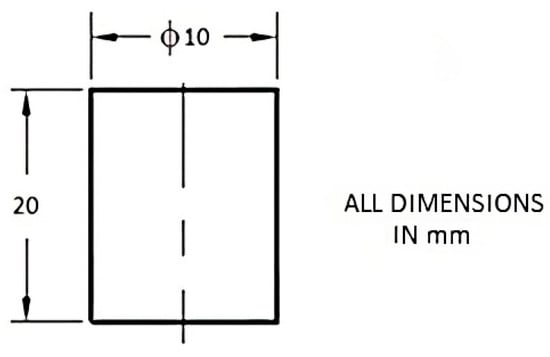
Figure 1.
Hardness test specimen for Micro Vickers hardness test and microstructure analysis.
1.2. Heat Treatment
Since the composite matrix was aluminum alloy, which responds positively to age-hardening treatment, and the reinforcement was ferrous metal (eutectoid steel), which responds to conventional annealing, austempering, and martempering treatments, the multiple heat treatments were carried out, as per the details shown in Figure 2, Figure 3 and Figure 4. In eutectoid steel, a fine pearlite phase of uniform grain size may be formed by isothermal treatment at 550 °C, after austenitizing at 750 °C. These three heat treatment cycles are detailed in Figure 2, Figure 3 and Figure 4 respectively, whereas the age-hardening treatment was carried out independently on the composites as explained in step 2 of the hybrid treatment.
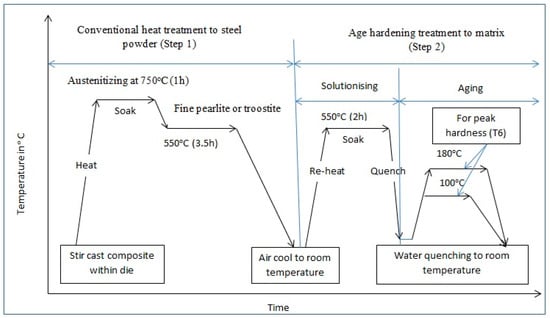
Figure 2.
Hybrid heat treatment following the pearlitic cycle.

Figure 3.
Hybrid heat treatment following the bainitic cycle.
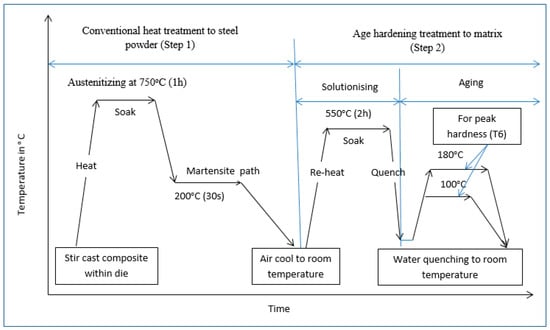
Figure 4.
Hybrid heat treatment following the martensitic cycle.
1.3. Age Hardening
The age-hardening process commenced after the solutionizing treatment at 550 °C for a period of 2 h, followed by quenching in water at room temperature. The samples were subsequently subjected to artificial aging in the furnace at temperatures of 100 °C and 180 °C for varying time intervals, with hardness distribution curves plotted against the isothermal aging time. According to the Al-Mg-Zn phase diagram, the melting temperature of the ternary eutectic phase, which contains a mixture of inter-metallic and solid solution phases, was noted as 550 °C [11]. During solutionizing, the harder MgZn2 intermetallic phase was observed to fully dissolve at 550 °C and subsequently precipitate as intermetallics during aging, reinforcing the matrix. These secondary precipitated phases contribute to the particle strengthening and the coherence between the crystal structures of the particle and the matrix. It has been documented that Al 7075 samples and their composites, following solution treatment at 550 °C, display an improved combination of strength and toughness properties [12].
1.4. Hybrid Heat Treatment (Pearlite Transformation)
Step 1—Conventional Heat Treatment of Steel Powder: The composite material undergoes heating to a temperature ranging from 30 to 50 °C above the critical temperature of steel (750 °C). This temperature is maintained isothermally for an optimal duration of 1 h, followed by quenching in a salt bath to 550 °C. Subsequently, it is held isothermally for 3.5 h, as per the isothermal transformation diagram of eutectoid steel, and air cooled to room temperature (step 1 in Figure 2). This process results in the transformation of the steel powder from its original coarse pearlite structure (as-bought phase) to fine pearlite, which is a stronger and harder phase than coarse pearlite. This transformation strains the matrix material, thereby altering its properties, particularly the hardness and strength.
Step 2—Age Hardening Treatment of Matrix Material: The partially heat-treated material from step 1 undergoes reheating to a temperature ranging from 50 to 100 °C above the solvus temperature (550 °C). It is then held isothermally for 2 h to transform into a single-phase solid solution, followed by quenching to room temperature to form a supersaturated solid solution. Upon quenching, the matrix becomes supersaturated, maintaining a crystal structure similar to that of the high-temperature phase without affecting the phases formed in the reinforcement during step 1. The supersaturated matrix phase undergoes reheating below the solvus temperature (100 and 180 °C) for peak aging (T6 treatment), followed by quenching to room temperature to halt further transformation processes (overaging), which could lead to a decrease in the strength and hardness due to particle coarsening. The new phase (pearlite) formed in the reinforcement (steel powder) during step 1 remains unaffected during step 2, as the heating temperature in step 2 is 550 °C, which is significantly below the critical temperature of steel. The entire treatment process is illustrated in Figure 2.
1.5. Hybrid Heat Treatment (Bainite Transformation)
Step 1—Conventional Heat Treatment of Steel Powder: The metal matrix composite undergoes heating to a temperature range of 30–50 °C above the critical temperature of steel; it is held isothermally for an optimal period of 1 h and then quenched in a salt bath at 350 °C. Subsequently, it is held isothermally for 3 h and air cooled to room temperature (step 1 in Figure 3). This treatment, known as conventional austempering, transforms the as-bought steel powder from its coarse pearlite structure to bainite, a phase stronger and harder than fine pearlite, thus affecting the properties of the matrix material.
Step 2—Age Hardening Treatment of Matrix Material: The partially heat-treated metal matrix composite materials obtained from step 1 are reheated to a temperature range of 50–100 °C above the solvus temperature (550 °C) and held isothermally for 2 h to convert into a single-phase solid solution. They are then quenched to room temperature to form a supersaturated solid solution. This quenching process maintains a crystal structure similar to that of the high-temperature phase without affecting the phases formed in the reinforcement during step 1. The supersaturated matrix phase undergoes reheating below the solvus temperature of the matrix for peak aging. Upon reaching peak aging conditions, the complete specimen is quenched (room temperature) to halt the softening of the matrix. During step 2, the new phase (bainite) formed in the reinforcement (steel powder) during step 1 remains unaffected. The entire hybrid heat treatment process following the bainitic path is illustrated in Figure 3.
1.6. Hybrid Heat Treatment (Martensite Transformation)
Step 1—Conventional Heat Treatment of Steel Powder: The metal matrix composite material is subjected to heating at a temperature ranging from 30 to 50 °C above the critical temperature of the steel, maintained isothermally for an optimal duration of 1 h, and then quenched to 200 °C in a salt bath. It is then maintained isothermally for 20 s before being cooled to room temperature with air (step 1 in Figure 4). This procedure, known as conventional martempering, transforms the as-bought steel powder’s coarse pearlite structure into martensite, a stronger and harder phase than bainite.
Step 2—Age Hardening Treatment of Matrix Material: The partially heat-treated metal matrix composite materials obtained from the previous step are reheated to a temperature range of 50–100 °C above the solvus temperature (550 °C) and held isothermally for 2 h, followed by quenching to room temperature to form a supersaturated solid solution. After quenching, the matrix becomes supersaturated, retaining the crystal structure of the high-temperature phase, while not changing the phases generated in the first step. The T6 treatment involves reheating the supersaturated matrix phase below the matrix’s solvus temperature. At the peak of aging, the entire specimen is quenched to room temperature to prevent further change. During step two, the new phase (martensite) created for steel reinforcing is unaffected. Figure 4 illustrates the full heat treatment process that follows the martensitic course.
1.7. Polishing
The specimens were initially polished with coarse emery papers of grades 60 and 80 in succession. This was followed by polishing using fine emery papers of grades 220, 300, 400, 600, 800, and 1000 in wet conditions using diamond paste. The final polishing was performed on the disc polisher with velvet cloth.
1.8. Sonication
Sonication is a process in which ultrasonic waves are used to agitate the solution sample. The samples after diamond polishing were treated in a sonicator with acetone to remove any micron-sized particles adhering to the surface of the specimen. Once the specimen was dipped into the solution, the sonicator probe was actuated. The following parameters were set for sonication: time duration: 5 min, amplitude: 30%, pulse: continuous.
2. Results and Discussion
2.1. Microstructural Analysis
The microstructure of the stir cast composites is shown in Figure 5. Figure 5a–c show the 2, 4, and 6 wt.% steel powder reinforcement respectively, which show a fairly uniform dispersion of powder particles in the matrix. The casting procedure used for the cast composite was described in our previous paper [9]. The agglomeration of particles is a serious threat for property enhancement in as-cast or heat-treated conditions. Hence, the reinforcement quantity in the composite was restricted to 6 wt.%. The recorded images did not display any blow holes or cracks, which shows the cast composites were sound for heat treatment and testing purposes.
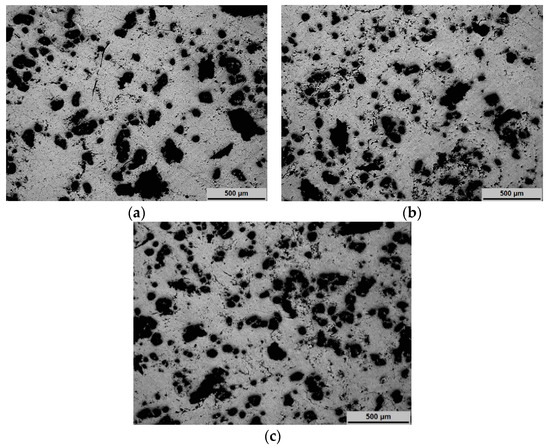
Figure 5.
Microstructure of (a) 2 wt.% steel powder-reinforced composite, (b) 4 wt.% reinforced composite, and (c) 6 wt.% reinforced composite.
Figure 6 is the SEM image of the as-cast composite, whereas Figure 7, Figure 8 and Figure 9 show the hybrid heat-treated composites. The as-cast structure shows the coarse pearlite (Figure 6) phase of steel reinforcement where clear distinguished lamellae of pearlite are seen. The fine pearlite, bainite, and martensite phases were observed in the hybrid treatment depending upon the alteration in the cooling cycle of the composite. Figure 7 shows the fine pearlite phase of the reinforcement formed due to the faster cooling of the composite in the first stage of hybrid treatment, where the isothermal holding at 550 °C modified the reinforcement phases into finer pearlite. It was the conventional heat treatment step in the steel, where after austenitizing at 900 °C, the modified cooling path (isothermal holding at 550 °C) transformed the steel phase into fine pearlite. Figure 8 shows the feathery structure of the reinforcement as marked. This feathery phase in steel transformation on soaking in the bainitic phase temperature (350 °C) is feathery bainite. Similarly, Figure 9 shows the martensite phase (single phase) for the reinforcement, which was the supersaturated single phase, unlike pearlite or bainite. The dark lines in the pearlite or bainite are cementite, where the region separating two consecutive cementite needles is ferrite. These three phases (ferrite, bainite, and martensite) did not show any phase alteration in the second stage (age hardening) treatment step of the hybrid treatment, because the heating temperature range for the second step of the heat treatment (age hardening) was well below the lower critical temperature (724 °C) of steel.
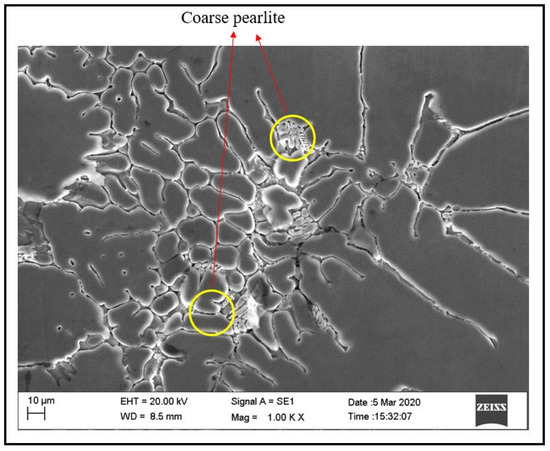
Figure 6.
SEM image of as-cast composite.
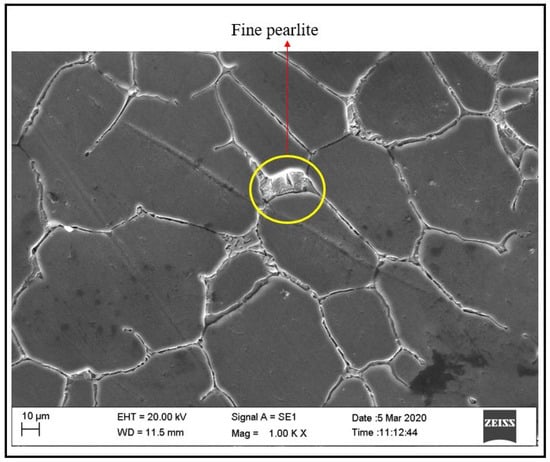
Figure 7.
SEM image of hybrid-treated (pearlite path) composite.
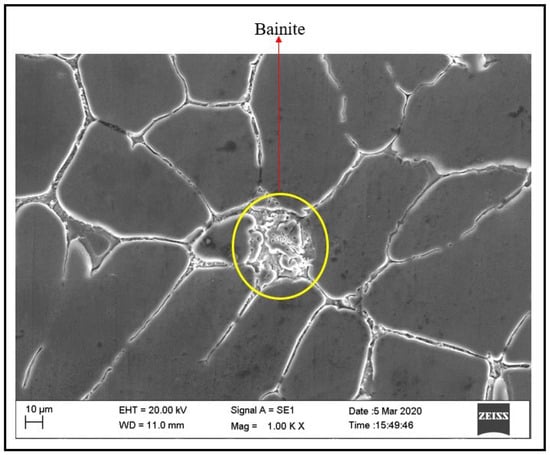
Figure 8.
SEM image of hybrid-treated (bainite path) composite.
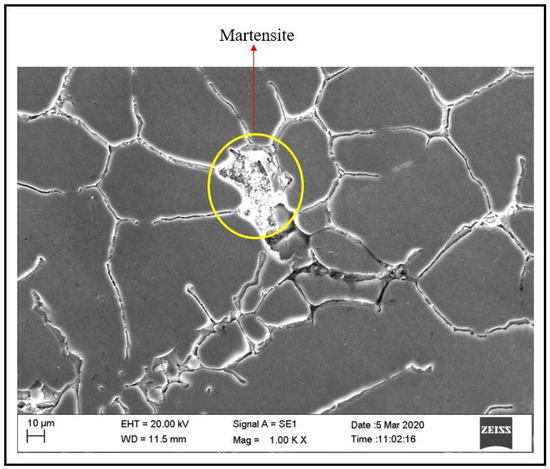
Figure 9.
SEM image of hybrid-treated (martensite path) composite.
The average of five consistent hardness values was tabulated, which showed the peak hardness in the conventional aging, pearlite, bainite, and martensite paths (Table 1). The variation in the results for the different trails with the same condition was negligible. The same results are shown in Figure 10 with the error bars for each condition. From the results in Table 1 and Figure 10, it may be seen that as the wt.% of steel powder increased, and as the temperature of the phase transformation decreased, the hardness of the composite increased. The results are well supported by the theory behind metal matrix composite and heat treatment [11].

Table 1.
Peak hardness of aged composites.

Figure 10.
Error bar graph for the hardness results for (a) composites aged at 100 °C and (b) composites aged at 180°.
2.2. Natural Aging
The natural aging curves for all the peak-aged composites are shown in Figure 11, Figure 12 and Figure 13. During natural aging, the hardness of the composites decreased irrespective of the reinforcement quantity involved in the composites and the type of reinforcement phase alterations in the hybrid heat treatment. During natural aging, stress relaxation takes place in the composite to reduce the free energy of the system. Due to the reduction in the coherency strain in the composite during overaging (natural aging), the hardness and UTS decrease with the reduction in the crystal imperfections, especially, the dislocations [12]. In all the cases, as time lapses, the natural aging severity decreases.
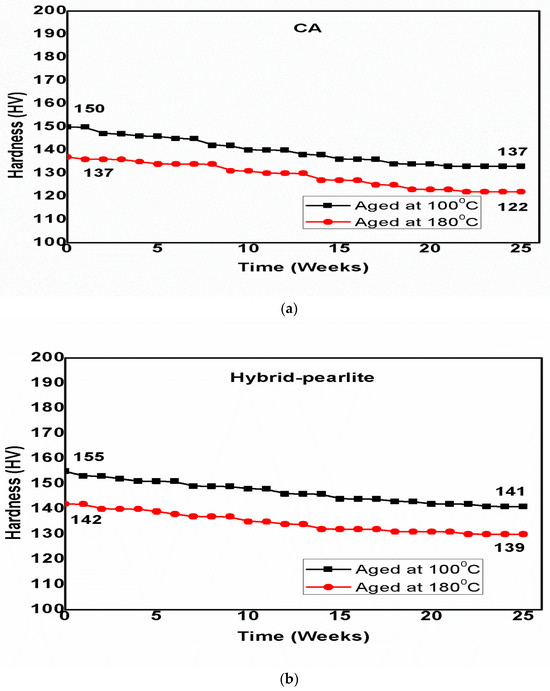
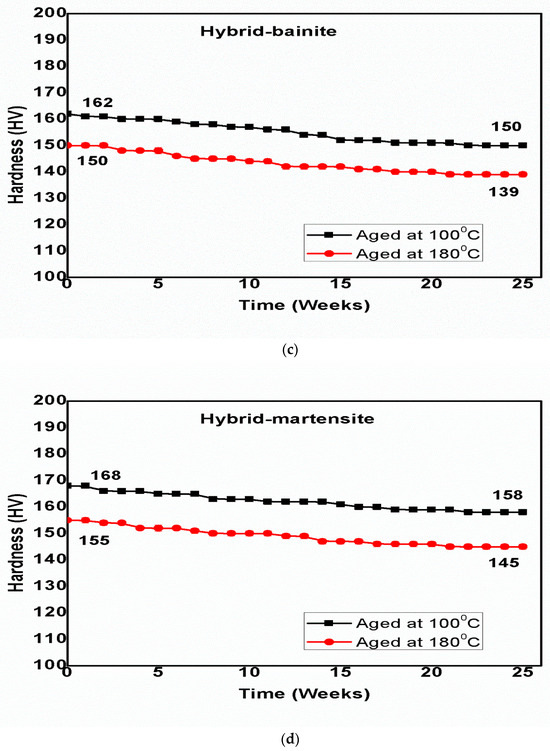
Figure 11.
Comparison of natural aging curves after peak aging for (a) CA, (b) hybrid-treated pearlite, (c) hybrid-treated bainite, and (d) hybrid-treated martensite for Al 7075–2 wt.% steel powder composites.
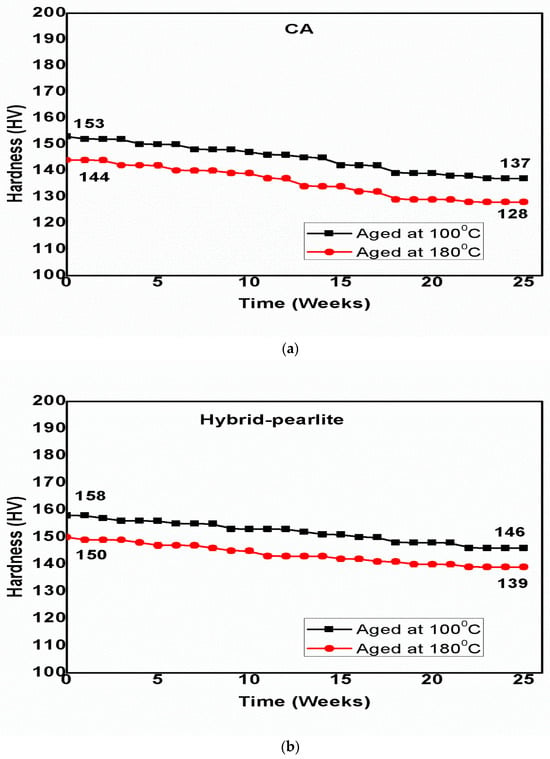
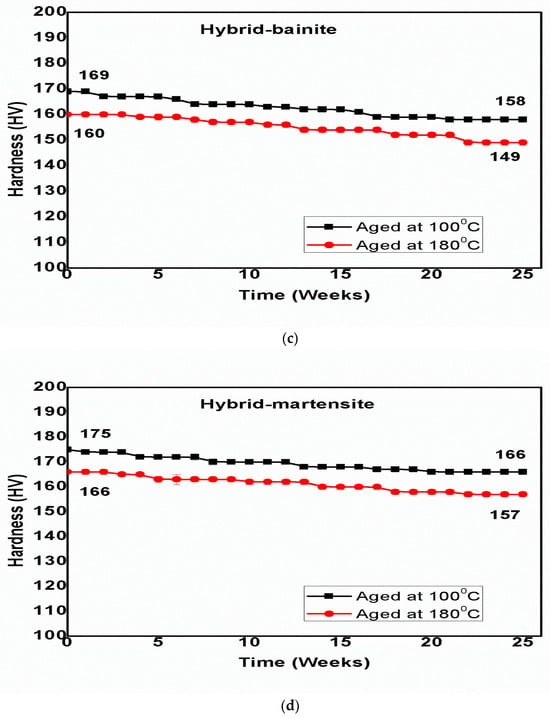
Figure 12.
Comparison of natural aging curves after peak aging for (a) CA, (b) hybrid-treated pearlite, (c) hybrid-treated bainite, and (d) hybrid-treated martensite for Al 7075–4 wt.% steel powder composites.
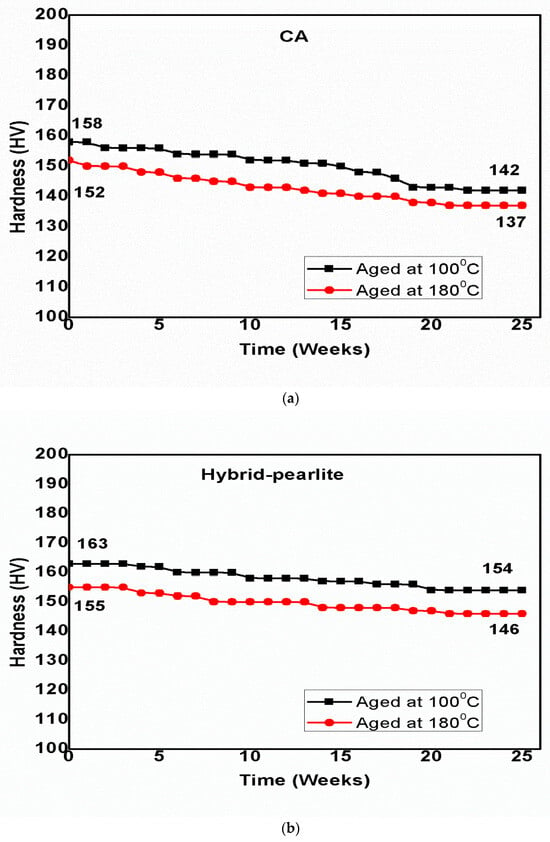
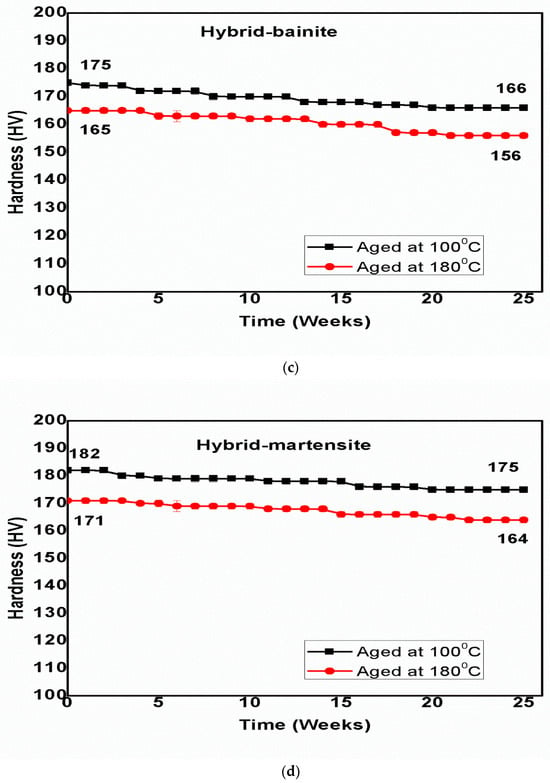
Figure 13.
Comparison of natural aging curves after peak aging for (a) CA, (b) hybrid-treated pearlite, (c) hybrid-treated bainite, and (d) hybrid-treated martensite for Al 7075–6 wt.% steel powder composites.
Table 2, Table 3 and Table 4 represent the severity of natural aging on the composites over 25 weeks of aging. It is observed from Figure 12 and Table 2 (for composite Al 7075–2 wt.% steel powder) that the natural aging severity was slightly higher, reducing the peak hardness values in the range of 6 to 11%, where the martensite phase-embedded composite showed good resistance (6% reduction) compared to the pearlite phase (poor resistance, i.e., 11% reduction). In all the heat-treated composites, hybrid heat treatment with the martensitic path showed good results (better resistance to natural aging). Accordingly, the martensite phase-reinforced composite showed excellent resistance for aging followed by the bainite phase, and the least resistant was the conventionally aged in all composite categories. The higher wt.% reinforced (6 wt.%) martensite-form composite showed the best result (excellent resistance for aging with a 4% reduction in hardness) among all categories of composites and heat treatments. When the martensite phase forms in the lattice, volume expansion takes place due to the lower packing factor; hence, the matrix experiences compressive strain, which will not easily allow the diffusion of atoms in the lattice (natural aging) [11].

Table 2.
Comparison of percentage reduction in peak hardness values during natural aging for CA and hybrid-treated Al 7075–2 wt.% steel powder composites over 25 weeks.

Table 3.
Comparison of percentage reduction in peak hardness values during natural aging for CA and hybrid-treated Al 7075–4 wt.% steel powder composites over 25 weeks.

Table 4.
Comparison of percentage reduction in hardness values during natural aging after peak aging for CA and hybrid-treated Al 7075–6 wt.% steel powder composites over 25 weeks.
Comparing Figure 11, Figure 12, Figure 13 and Figure 14 (both composites and base alloy), it can be concluded that the base alloy has the lowest resistance to the natural aging phenomenon (approx. 20% reduction) due to the lower number of nucleation sites (crystal imperfections) [12]. Figure 14 shows the natural aging curves for the peak-aged base alloy (Al 7075) at 100 and 180 °C aging temperatures. Compared to the slope of the natural aging curves of the composites (Figure 4, Figure 5 and Figure 6), the slope of the natural aging curves of the base alloy (Figure 14) was high, indicating a poor resistance to the natural aging process. This indicates that the incorporation of a higher quantity of the steel powder reinforcement into the Al 7075 matrix and the application of nonequilibrium cooling during heat treatment curtails the natural aging phenomena.

Figure 14.
Natural aging curves after peak aging for the conventionally aged base alloy (Al 7075).
Table 2, Table 3 and Table 4 show that the conventional aging for the 2 wt.% steel powder-reinforced composite has poor resistance (11% reduction) to hardness reduction as compared to the martensite phase-reinforced (6 wt.%) composite (4% reduction). This is represented in Table 5.

Table 5.
Peak hardness difference (%) in natural aging over 25 weeks for Al 7075–steel powder-reinforced composites.
3. Conclusions
The composites are successfully heat treated using a hybrid method. The microstructure of the hybrid-treated composites shows the evidence for the reinforcement phase transformation, well supported by the hardness data. Based on the results obtained and the analysis, it is concluded that on natural aging, the hardness of the composites decreases irrespective of the reinforcement quantity involved in the composites and the type of reinforcement phase alteration during the hybrid heat treatment. It is observed that in all composites, as time lapses, the natural aging severity decreases, and the martensite phase-reinforced composite shows excellent resistance for natural aging followed by the bainite phase. Among all, the 6 wt.% quantity steel powder-reinforced alloy shows the best resistance to the natural aging phenomena. It is also noted that the base alloy shows poor natural aging resistance (the hardness decrease is approximately 20%) compared to the composites.
Author Contributions
Conceptualization, A.H. and K.B.M.; methodology, S.S. and G.M.C.; investigation, G.A.; resources, A.H. and R.V.S.; data curation, K.B.M. and R.V.S.; original draft preparation, S.S.; writing—review and editing, K.B.M. and G.A. All authors have read and agreed to the published version of the manuscript.
Funding
No funding was received for the work.
Data Availability Statement
All the related data are available within the manuscript.
Conflicts of Interest
The authors declare that they do not have any conflicts of interest.
References
- Rebba, B.; Ramanaiah, N. Evaluation of mechanical properties of aluminium alloy (Al-7075) reinforced with molybdenum disulphide (MoSi2) metal matrix composites. Procedia Mater. Sci. 2014, 6, 1161–1169. [Google Scholar] [CrossRef]
- Sameezadeh, M.; Emamy, M.; Farhangi, H. Effects of particulate reinforcement and heat treatment on the hardness and wear properties of Al 7075-MoSi2 nanocomposites. Mater. Des. 2011, 32, 2157–2164. [Google Scholar] [CrossRef]
- Sharma, P.; Chauhan, G.; Sharma, N. Production of AMC by stir casting—An overview. Int. J. Contemp. Pract. 2011, 2, 23–46. [Google Scholar]
- Kok, M. Production and mechanical properties of Al2O3 particle-reinforced 2024 aluminium alloy composites. J. Am. Acad. Dermatol. 2005, 161, 381–387. [Google Scholar] [CrossRef]
- Garg, P.; Jamwal, A.; Kumar, D.; Sadasivuni, K.K.; Hussain, C.M.; Gupta, P. Advance research progresses in aluminium matrix composites: Manufacturing & applications. J. Mater. Res. Technol. 2019, 8, 4924–4939. [Google Scholar]
- Mahathaninwong, N.; Plookphol, T.; Wannasin, J.; Wisutmethangoon, S. T6 heat treatment of rheocasting 7075 Al alloy. Mater. Sci. Eng. 2012, 532, 91–99. [Google Scholar] [CrossRef]
- Reda, Y.; Abdel-Karim, R.; Elmahallawi, I. Improvements in mechanical and stress corrosion cracking properties in Al 7075 via retrogression and re aging. Mater. Sci. Eng. 2008, 485, 468–475. [Google Scholar] [CrossRef]
- Sevim, I.; Sahin, S.; Cug, H.; Cevik, E.; Hayat, F.; Karali, M. Effect of aging treatment on surface roughness, Mechanical properties, and fracture behaviour of 6xxx and 7xxx aluminium alloys. Strength Mater. 2014, 46, 190–197. [Google Scholar] [CrossRef]
- Bhat, R.; Hegde, A.; Sharma, S.; Shankar, G.; Murthy, G. Hybrid Heat Treatment for Conventionally Treatable Steel Powder Reinforced Age Hardenable Aluminium Alloy Matrix Composites and Mechanical Property Evaluation. Mater. Res. 2022, 25, 1–9. [Google Scholar] [CrossRef]
- ASTM E18-02; Standard Test Methods for Rockwell Hardness and Rockwell Superficial Hardness of Metallic Materials. ASM International: Almere, The Netherlands, 2001.
- Avner, S.H. Introduction to Physical Metallurgy; McGraw-Hill: New York, NY, USA, 2012. [Google Scholar]
- Rajan, T.V.; Sharma, C.P.; Sharma, A. Heat Treatment: Principles and Techniques; PHI Learning Pvt. Ltd.: Delhi, India, 2012. [Google Scholar]
Disclaimer/Publisher’s Note: The statements, opinions and data contained in all publications are solely those of the individual author(s) and contributor(s) and not of MDPI and/or the editor(s). MDPI and/or the editor(s) disclaim responsibility for any injury to people or property resulting from any ideas, methods, instructions or products referred to in the content. |
© 2024 by the authors. Licensee MDPI, Basel, Switzerland. This article is an open access article distributed under the terms and conditions of the Creative Commons Attribution (CC BY) license (https://creativecommons.org/licenses/by/4.0/).